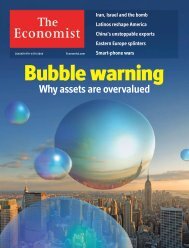Untitled - the ultimate blog
Untitled - the ultimate blog
Untitled - the ultimate blog
You also want an ePaper? Increase the reach of your titles
YUMPU automatically turns print PDFs into web optimized ePapers that Google loves.
ates for 2009 as a whole could give a misleading picture. Take<br />
Taiwan: JPMorgan predicts that its GDP in 2009 will be 3.8% lower<br />
than in 2008, implying ano<strong>the</strong>r dismal year. But this forecast also<br />
implies that GDP will grow by a brisk 5.4% in <strong>the</strong> year to <strong>the</strong><br />
fourth quarter. By this measure, Asia’s emerging economies are<br />
clearly leading <strong>the</strong> global recovery (see chart 2). Even if America’s<br />
economy grows during <strong>the</strong> second half of this year, it is still<br />
expected to end <strong>the</strong> year smaller than it was at <strong>the</strong> start.<br />
Asia’s bounce has taken<br />
many forecasters by<br />
surprise. In May, for<br />
example, <strong>the</strong> IMF predicted<br />
that Asia’s recovery was<br />
likely to be “tepid” because<br />
<strong>the</strong> developed economies—<br />
and hence demand for<br />
Asian exports—would<br />
remain weak. Forecasters<br />
always seem to<br />
underestimate <strong>the</strong> ability of<br />
<strong>the</strong> Asian tigers to rebound<br />
from recessions. During<br />
East Asia’s financial crisis in<br />
1997-98, for example,<br />
countries across <strong>the</strong> region<br />
were forced to devalue as a<br />
result of large currentaccount<br />
deficits and<br />
speculative attacks on <strong>the</strong>ir currencies. This caused firms’ foreign-currency debts to swell in local terms,<br />
resulting in widespread bankruptcies and bank failures. In 1998 <strong>the</strong> real GDP of Thailand, Indonesia and<br />
South Korea fell by an average of 10%.<br />
Many foreigners concluded that Asia’s economic success had been a complete sham, based on<br />
governments pouring cheap money into favoured firms. Over-borrowing and over-investment had<br />
artificially boosted growth, it was argued; doomsayers predicted a decade of lost growth. Instead, <strong>the</strong><br />
tigers came roaring back. At <strong>the</strong> end of 1998 The Economist’s poll of forecasters predicted that South<br />
Korea would shrink again slightly in 1999. Its actual growth turned out to be a stunning 9.5%. It was true<br />
that Asia’s strong growth had concealed wasteful investment, inadequate bank regulation and corruption,<br />
but <strong>the</strong> key ingredients of growth—rapid productivity growth, relatively open markets and a high saving<br />
rate to finance investment—remained in place. That helps explain why <strong>the</strong> East Asian economies<br />
recovered more quickly than many expected.<br />
A case of Asia vu<br />
Likewise, when <strong>the</strong> global information technology bust dragged Asia into recession in 2001, forecasters<br />
turned out to be much too gloomy about Asia’s prospects. Once again, emerging Asia bounced back fairly<br />
briskly. Westerners have always been too quick to pronounce <strong>the</strong> death of <strong>the</strong> Asian economic miracle.<br />
This may be wishful thinking, but it also reflects some misunderstandings about <strong>the</strong> ingredients of Asia’s<br />
success. This year it was widely predicted that Asia’s economies would not recover until after America and<br />
Europe had revived. Yet Asia’s supposedly export-dependent economies have resumed growth before <strong>the</strong><br />
rest of <strong>the</strong> world. How can that be?<br />
Sceptics argue that <strong>the</strong> pick-up simply reflects a temporary boost from rebuilding inventory, with no real<br />
increase in demand. Firms had cut production to below <strong>the</strong> level of sales in order to shed excess<br />
inventories, so now <strong>the</strong>y need to reopen factories. This may be a factor in some countries, but in o<strong>the</strong>rs<br />
firms are still running down <strong>the</strong>ir stocks.<br />
In South Korea <strong>the</strong> decline in inventories accelerated in <strong>the</strong> second quarter, and <strong>the</strong> leanness of stocks<br />
bodes well for fur<strong>the</strong>r gains in production over <strong>the</strong> rest of this year. Instead, <strong>the</strong> recovery has been led by<br />
investment and consumer spending. South Korea’s private consumption rose by an annualised 14% in <strong>the</strong><br />
second quarter. In China fixed investment (on a GDP-consistent basis) is running more than 20% higher<br />
than a year ago, real consumer spending in urban areas is up by almost 11% and car sales have surged<br />
-102-








![[ccebbook.cn]The Economist August 1st 2009 - the ultimate blog](https://img.yumpu.com/28183607/1/190x252/ccebbookcnthe-economist-august-1st-2009-the-ultimate-blog.jpg?quality=85)



![[ccebook.cn]The World in 2010](https://img.yumpu.com/12057568/1/190x249/ccebookcnthe-world-in-2010.jpg?quality=85)
![[ccemagz.com]The Economist October 24th 2009 - the ultimate blog](https://img.yumpu.com/5191885/1/190x252/ccemagzcomthe-economist-october-24th-2009-the-ultimate-blog.jpg?quality=85)